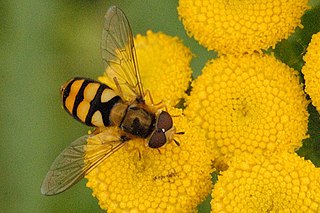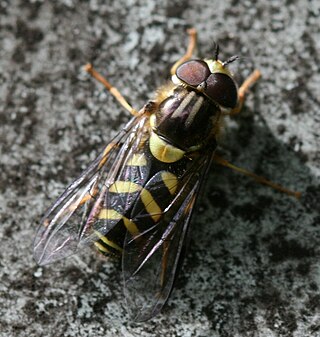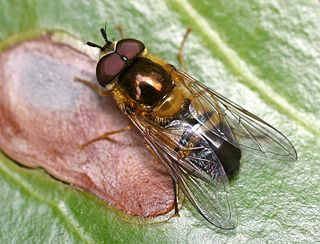
Syrphus ribesii is a very common Holarctic species of hoverfly. Its larvae feed on aphids. In common with many other species of hoverfly, males have the eyes meeting on the top of the head, whilst females have their eyes widely separated.

Leucozona glaucia, the Pale-saddled Leucozona is a Palearctic hoverfly. Larvae feed on ground layer aphids. Adults are usually seen visiting flowers.

Eupeodes luniger is a common species of hoverfly.

Eupeodes latifasciatus is a species of hoverfly. Adults feed on nectar; larvae feed on aphids and scale insects.

Dasysyrphus albostriatus is a Palearctic species of hoverfly.

Dasysyrphus venustus is a Holarctic species of hoverfly.

Epistrophe eligans is a European species of hoverfly.

Leucozona lucorum is a Palearctic and Nearctic species of hoverfly.

Parasyrphus annulatus is a Palearctic species of hoverfly.

Xanthandrus comtus is a species of hoverfly. It is found in the Palearctic.

Fagisyrphus cinctus is a European species of hoverfly. This species has a muddled taxonomic history. Older authors treated it as a member of the genus Melangyna, and later sources in Meligramma, but the most recent sources recognize it as the sole species in its own monotypic genus, Fagisyrphus.

Syrphus vitripennis is a very common European and North American species of hoverfly. Its larvae feed on aphids

Epistrophe grossulariae is a Holarctic species of hoverfly.

Parasyrphus lineolus is a Holarctic species of hoverfly.

Parasyrphus vittiger is a species of hoverfly, from the family Syrphidae, in the order Diptera.
Heringia heringi is a European species of hoverfly.

Melangyna compositarum is a Holarctic species of hoverfly.

Megasyrphus erraticus is a Holarctic species of hoverfly associated with mature conifer woodlands and plantations.

Didea alneti is a Holarctic species of hoverfly.

Epistrophe nitidicollis is a European and North American species of hoverfly.




















